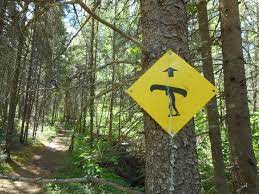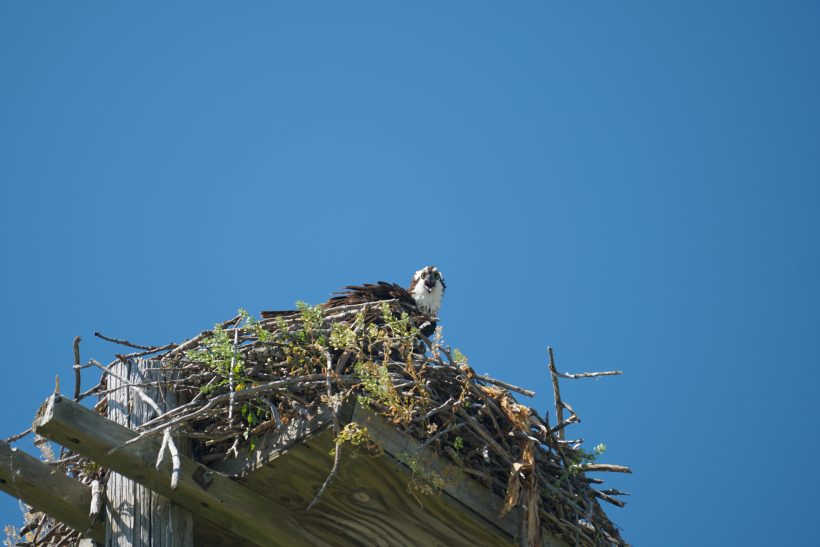PLACES TO REMEMBER by Ralph Bice
From January 25, 1979
One of the earliest things l remember was a tall pine stub that stood in the woods perhaps a mile from our house. It must have been a magnificent tree when growing for it seemed to stand so far above the rest of the trees as many pine once did. But what made this one unusual was that on the very top was an osprey nest. At that time, these large birds were called ‘fish hawks’ caught a lot of fish. I do not remember seeing young birds but it was common to see these hawks diving from quite a height and getting a fish that was close to the surface.
The first year l guided in Algonquin Park l saw a grove of pine trees that l would imagine was about the best in Ontario. This on Crotch Lake, on the Opeongo River. I was very much the junior guide in 1917 but one of the older guides suggested l paddle the two ladies in the party over to a certain bay on the lake and show them the pine trees. This also would mean that the three men in the party could go fishing without being bothered by the ladies.
Such a forest of pine trees. We went ashore and just walked through the trees. I imagine the hillside, not a very large hill, was well over fifty acres. And very few trees other than pine. Some were quite large, more than forty inches at the butt. And all so tall. It would have been no trouble to drive a team and wagon all through the stand of trees. The ladies noticed it and it has been said that to walk through a stand of large pine trees gave one a feeling of walking through a stately cathedral.
I made the trip several times the next few years and always managed to walk through those trees. Then in the mid-twenties came the lumbermen and those nice pines were cut into logs, loaded on to a train and headed for Ottawa. So many times, when reading of stories about pine trees, l think how fortunate l was to have been able to walk through that lovely bunch of trees. Any trees are nice, the mature forest of course being the best, but there is nothing, absolutely nothing can be as nice in the woods as a stand of virgin pine trees.
Then there are campsites. During the more than sixty years that l guided fishing and camping parties l camped so many places. Any spot on a clean shore close to the water and trees has to be nice. Some are nicer than others. There is one spot on the Crow River, or rather there was years ago, that just had to be the most restful spot on the river, or any where else. About midway across the portage in a grove of small pine trees and on a nice level spot close to the running water. I do not know if one could get the same feeling camping there with a large party but after stopping there once we used to try and plan our travel so we might stop and camp at that site. Sometimes we could catch enough fish in the rapids for a meal but when the water was low the fish seemed to disappear. The main thing was just to rest and relax.
Those days we seldom saw another party and the woods would be so quiet. Another thing, we proved at that campsite that when you are camped beside a flowing stream always sleep with your feet pointed downstream as the magnetic currents followed the stream and would pass through your body. If you slept the opposite way, seems like they stopped in your head preventing a good night’s rest. If camped away from a stream your feet should point south for the same reason.
For real beauty and a lovely camping spot there is nothing to compare with the old campsite on Eagle Lake, now called Butt Lake but the campsite has not been so nice since the name was changed and so many people visited the lake. I saw it first in 1911 when on a trip with my dad. When l started to guide l fished the lake as often as l could. The fishing was about the best; the lake one of the most beautiful in the Park, and such a fine spot to camp.
Just enough rise from the water level to insure a dry camp. Plenty of dry firewood close by, a southern exposure, where we could see the sun going down and on a clear morning see it rise except you had to get out of bed.
The lake, one of the highest on the Petawawa River system, has very clear water. The shores are clean and before the lumbermen came along there were many pines standing so much taller than the other trees.

In the olden days, to get to the lake meant canoeing and a series of portages. If you were staying a while there were times it meant making three trips on the portages. In all, the portages would total a bit over two miles. That meant a trip from the railroad to Butt Lake you would have to walk six miles, with heavy loads, and four miles where you sort of rested walking back for another load.
But it was worth it. Few people in the woods, so it seemed, you were away back. Then paddle out of the west bay and in a mile you came to the main lake and always a thrill to see it even if you had seen it the week before.
Years later when we had our permanent camp there in the summer months and went in the road by truck the lake was still as nice. Even when it was so easy to get to. Always, it did not seem right to be leaving though times we would be going back the next day.
So many pleasant memories. The best would have to be of the long ago trips when canoeing and portaging. So many pleasant evenings just sitting around the campfire and feeling you were away back in the woods.
Eagle, or Butt Lake, is still one of the most beautiful of all lakes. Not quite the same when there are so many boats and canoes, but the water is still nice; the hills , even with the tall pines gone are still nice; the sun still comes up in the same spot and the air is just as clean.
So, with all the places l have been, nothing is even a close second to Eagle (Butt) Lake and that awfully fine camping spot.
